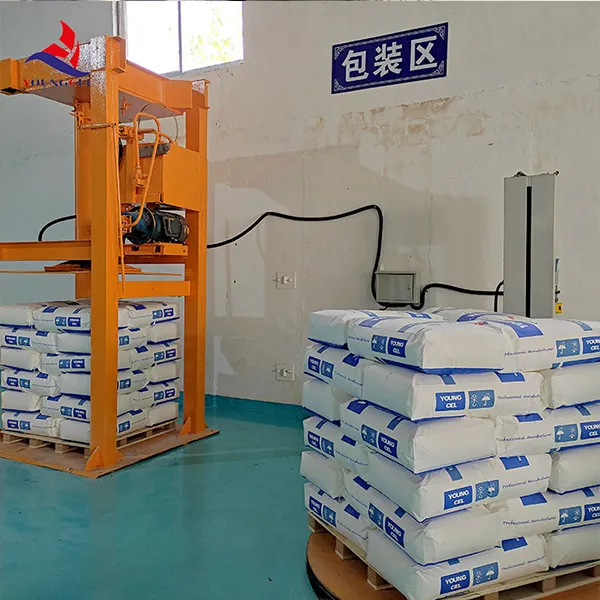Hydroxypropyl Methyl Cellulose (HPMC) A Versatile Polymer for Modern Applications
In the realm of polymers, Hydroxypropyl Methyl Cellulose (HPMC) stands out as a vital ingredient due to its unique properties and versatile applications. HPMC is a cellulose ether derived from natural cellulose, and it has gained immense popularity in various industries such as pharmaceuticals, food, construction, and cosmetics due to its excellent thickening, binding, and film-forming properties.
Properties of HPMC
HPMC is a white, odorless powder that is soluble in cold water but insoluble in hot water. This solubility profile makes it an ideal candidate for applications requiring controlled viscosity and texture. The polymer exhibits various thermal and rheological characteristics, making it suitable for diverse formulations. Its ability to form gels and films is particularly noteworthy, facilitating use in coatings, adhesives, and controlled-release systems.
One of the key attributes of HPMC is its non-toxic and biodegradable nature. These properties align with the growing demand for sustainable materials, making HPMC a preferable option in numerous formulations. It is also compatible with a wide range of excipients, further enhancing its utility in pharmaceutical formulations.
Pharmaceutical Applications
In the pharmaceutical industry, HPMC is widely used as a tablet binder and a controlled-release agent. When employed as a binder, it enhances the mechanical strength and disintegration properties of tablets. Its film-forming properties are crucial in the coating of tablets and capsules, protecting the active ingredients from environmental factors and ensuring a smooth swallowing experience.
Moreover, HPMC is extensively used in the formulation of controlled-release dosage forms. Its unique viscosity characteristics allow for the modulation of drug release rates, which can significantly improve therapeutic outcomes. The ability of HPMC to form an insoluble gel upon hydration enables it to function effectively in various drug delivery systems, from ocular preparations to sustained-release tablets.
hydroxypropyl methyl cellulose(hpmc)

Food Industry Applications
HPMC's applications extend beyond pharmaceuticals into the food industry, where it functions as a thickening agent, emulsifier, and stabilizer. It is often used in low-fat and gluten-free food products to improve texture and mouthfeel. By creating viscosity, HPMC enhances the sensory attributes of food, providing a smooth and creamy consistency that can replace fat without compromising on quality.
In addition to its thickening properties, HPMC acts as a moisture-retaining agent, which is particularly advantageous in baked goods. This helps extend shelf life by inhibiting staleness and maintaining freshness. Furthermore, its ability to form films aids in the personalized coating of food items, creating barriers that can protect flavor and freshness.
Construction and Cosmetic Applications
The construction industry also benefits from the properties of HPMC, utilizing it in tile adhesives, joint compounds, and plasters. Its water-retention capabilities allow for better adhesion and workability in cement-based formulations, improving performance and durability in construction projects.
In cosmetics, HPMC serves as a thickener and emulsifier in a variety of products, including creams, lotions, and gels. Its compatibility with other ingredients ensures stability and consistency in formulations, while its non-irritating nature makes it suitable for sensitive skin applications.
Conclusion
Hydroxypropyl Methyl Cellulose is a multifaceted polymer with extensive applications across various industries, including pharmaceuticals, food, construction, and cosmetics. Its unique properties, such as solubility in cold water, film-forming ability, and non-toxic nature, make it a valuable ingredient in product formulations. As the demand for innovative and sustainable solutions continues to rise, HPMC is poised to play an increasingly prominent role in enhancing product performance and consumer satisfaction. With ongoing research and development, the potential uses of HPMC are expanding, promising even greater versatility and applications in the future.
-
Rdp Powder: Key Considerations for Wholesalers in the Building Materials IndustryNewsJul.08,2025
-
Key Considerations for Wholesalers: Navigating the World of Hpmc - Based ProductsNewsJul.08,2025
-
Hpmc Detergent: Key Considerations for WholesalersNewsJul.08,2025
-
Key Considerations for Wholesalers: China Hpmc For Tile Adhesive, Coating Additives, Concrete Additives, and MoreNewsJul.08,2025
-
Crucial Considerations for Wholesalers: Navigating the World of Construction MaterialsNewsJul.08,2025
-
Key Considerations for Wholesalers Sourcing Additive For Cement, Additive For Concrete, Additive For Putty from Additive Manufacturer Shijiazhuang Gaocheng District Yongfeng Cellulose Co., Ltd.NewsJul.08,2025




